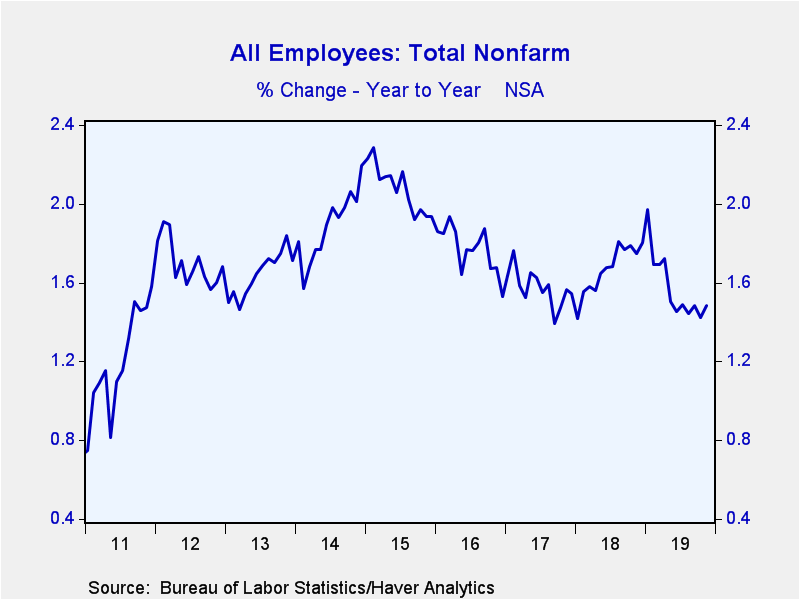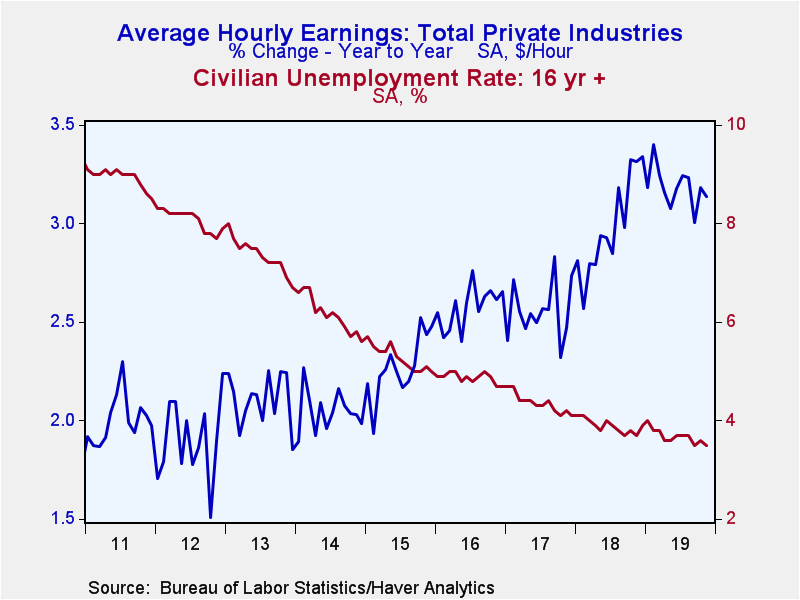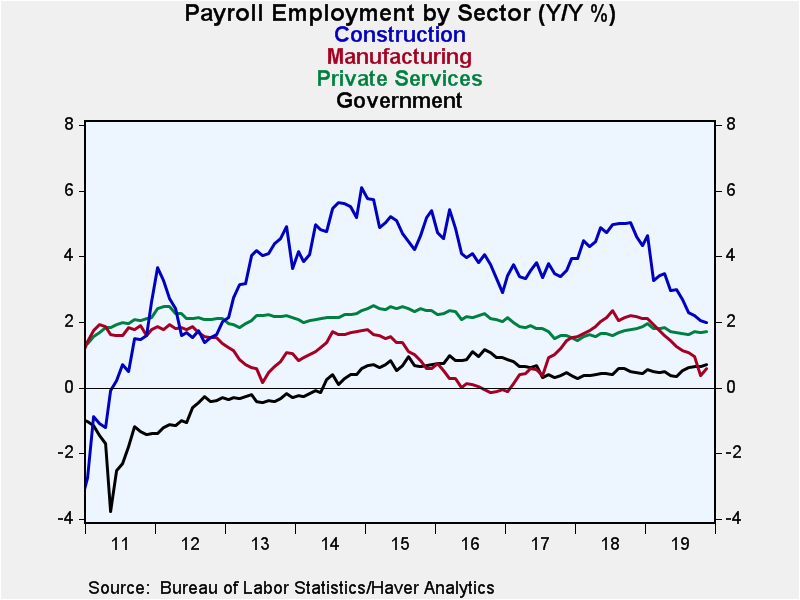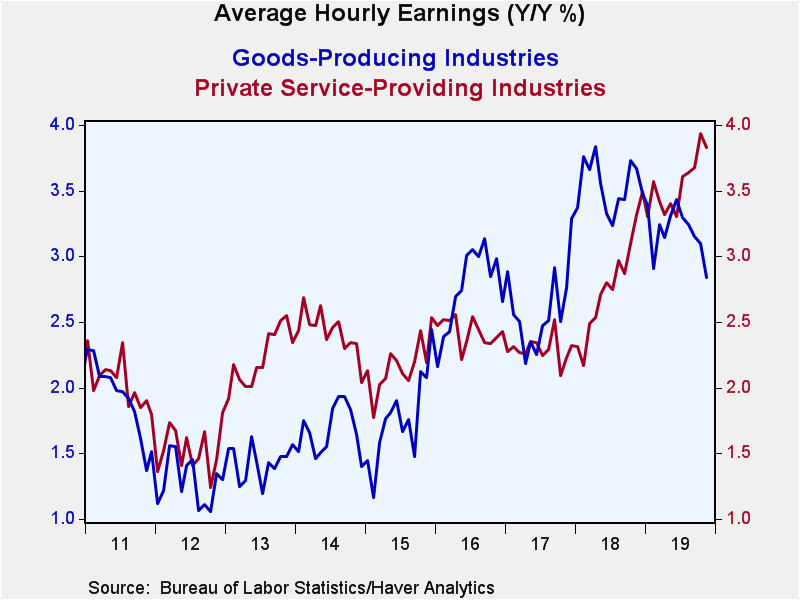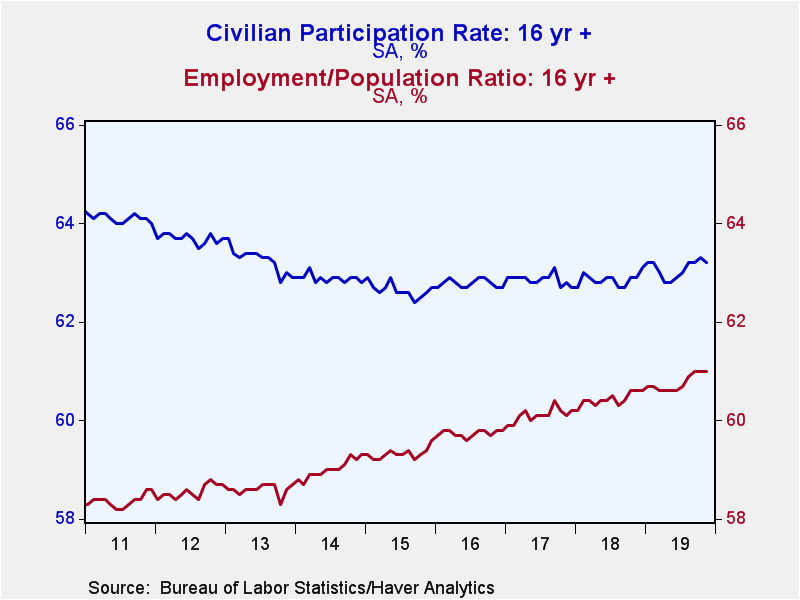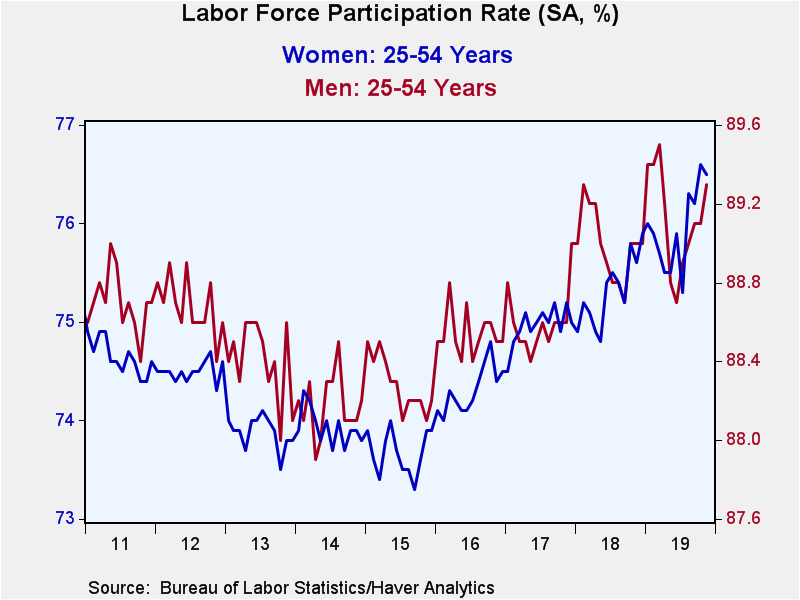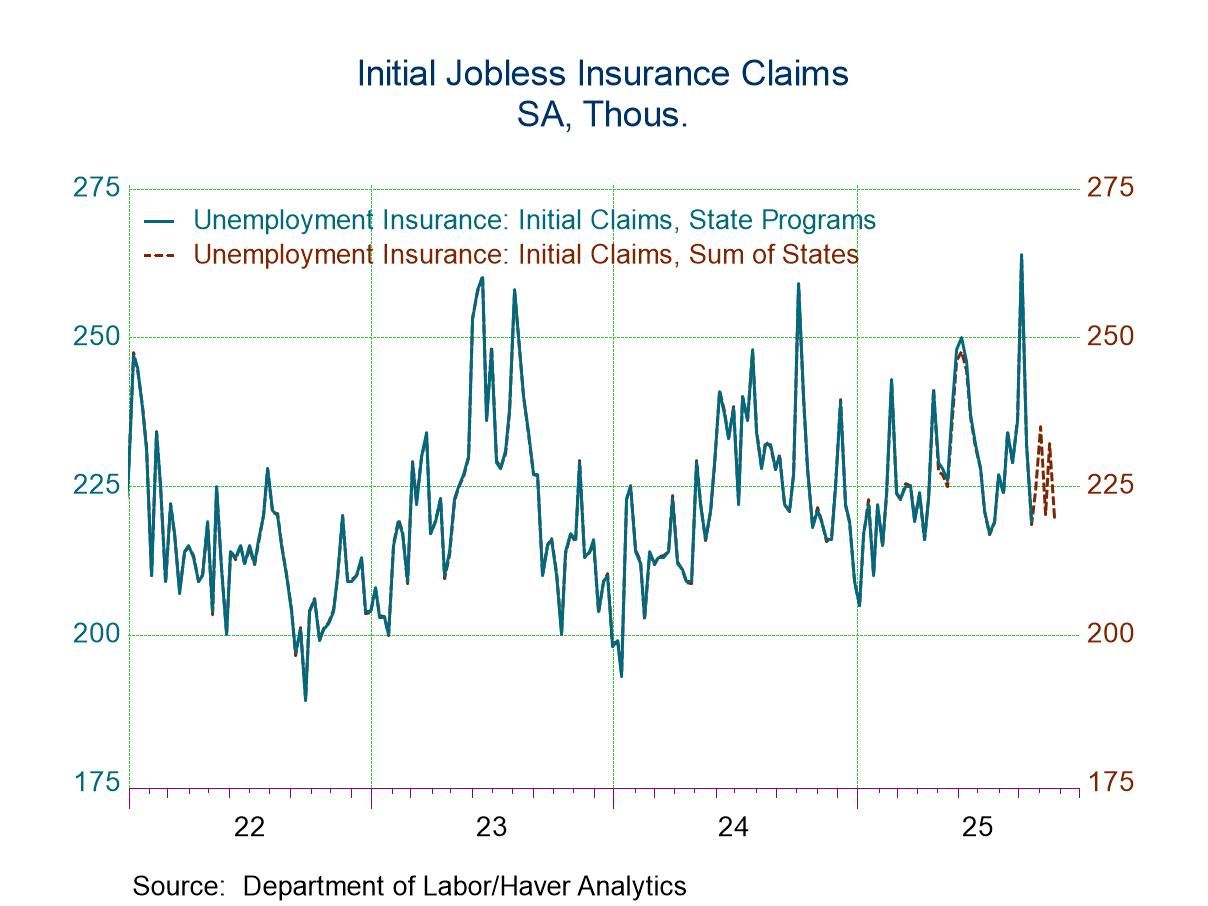 Global| Dec 06 2019
Global| Dec 06 2019U.S. Nonfarm Payroll Growth Rebounds; Wages Firm & Jobless Rate Eases
by:Tom Moeller
|in:Economy in Brief
Summary
The labor market firmed during November. Nonfarm payroll employment increased 266,000 (1.5% y/y) after rising 156,000 in October, revised from 128,000. September employment rose 193,000, revised from 180,000. A 184,000 November [...]
The labor market firmed during November. Nonfarm payroll employment increased 266,000 (1.5% y/y) after rising 156,000 in October, revised from 128,000. September employment rose 193,000, revised from 180,000. A 184,000 November increase had been expected in the Action Economics Forecast Survey. So far this year, payrolls overall have risen an average 180,000 per month after a 223,000 monthly average in 2018. Payrolls rose an average 205,000 since August.
Average hourly earnings in the private sector increased 0.2% in November following a 0.4% October gain, revised from 0.2%. A 0.3% rise had been expected. Growth during the last twelve months of 3.1% remained below the recent y/y peak of 3.4% logged in February.
The unemployment rate eased to 3.5% after rising to 3.6% in October. Stability at 3.6% had been expected. Employment in the household survey rose 83,000 (1.1% y/y) and the labor force increased 40,000 (1.0% y/y). The overall jobless rate, including those who were marginally attached or working part-time for economic reasons, eased to 6.9% from October's 7.0% and equaled the lowest level since December 2000.
From the payroll employment survey, the 266,000 jobs increase incorporated the end of a labor dispute at GM which added 41,000 to payrolls. Overall factory sector employment rose 54,000 (0.6% y/y) following a 43,000 October decline. Construction sector payrolls edged 1,000 higher (1.9% y/y) following a 14,000 gain. Mining & logging sector jobs fell 7,000 (-0.5% y/y).
Private service sector jobs surged 206,000 (1.7% y/y) after a 188,000 rise. Education & health care employment rose 74,000 (2.9% y/y) while leisure & hospitality hiring improved 45,000 (2.6% y/y). The number of professional & business service sector jobs increased 38,000 (2.0% y/y) including a 4,800 increase (0.2% y/y) in temporary jobs. Trade, transportation & utilities employment gained 14,000 (0.4% y/y) including a 2,000 gain (-0.2% y/y) in retail trade. Financial sector employment rose 13,000 (1.4% y/y) as did the number of information services jobs (0.4% y/y).
Government sector employment rebounded 12,000 last month (0.7% y/y) after easing 7,000 during October. All of the increase owed to a 13,000 increase (0.8% y/y) in local government jobs while federal government employment slipped 1,000 (+1.0% y/y) and state government hiring held steady (0.3% y/y).
The 0.2% increase in average hourly earnings reflected 0.4% increases in both factory sector (3.0% y/y) and construction sector (2.7% y/y) pay. Mining sector earnings eased 0.2% (+6.1% y/y). Private service sector earnings improved 0.3% (3.2% y/y), reflecting 0.4% gains in both leisure & hospitality (3.5% y/y) and professional & business services (3.7% y/y). Trade, transportation & utilities earnings also rose 0.4% (3.8% y/y). Financial activities pay grew 0.2% (2.6% y/y), but education & health service sector earnings eased 0.1% (+2.0% y/y).
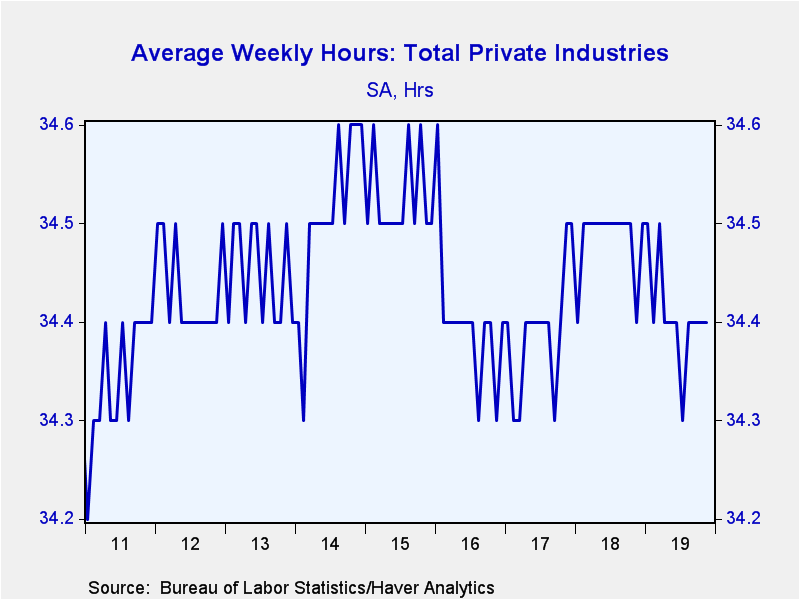 The length of the average workweek held steady at 34.4
hours for the third straight month. Mining sector hours eased to 46.2 while
factory sector hours improved to 40.5. The length of the construction sector
workweek slipped to 39.1 hours. Private service sector hours held steady at
33.2, but financial services hours improved to 37.8. Information
services hours eased to 36.3 while education & health sector hours improved
slightly to 33.1 hours. Professional & business service sector hours held at
36.2. The length of the workweek in the leisure & hospitality sector held
steady at a greatly reduced 25.8 hours.
The length of the average workweek held steady at 34.4
hours for the third straight month. Mining sector hours eased to 46.2 while
factory sector hours improved to 40.5. The length of the construction sector
workweek slipped to 39.1 hours. Private service sector hours held steady at
33.2, but financial services hours improved to 37.8. Information
services hours eased to 36.3 while education & health sector hours improved
slightly to 33.1 hours. Professional & business service sector hours held at
36.2. The length of the workweek in the leisure & hospitality sector held
steady at a greatly reduced 25.8 hours.
From the household survey of employment, the lower 3.5% unemployment rate and the strong gain in the labor force reflected a weakened labor force participation rate of 63.2%. That was up, nevertheless, from the September 2015 low of 62.4%. The teenage participation rate increased to 36.0% but for those aged 20-24, it declined to 71.7%, a nine-month low. For workers aged 25-54, the rate held steady at a cycle high of 82.8%. For men in that age bracket, the rate rose slightly to 89.3%. For women of that age, it eased to 76.5%, but remained near the highest level since March 2001, up from 73.7% during all of 2015. For workers aged 55 & over, the participation rate was steady m/m at 40.3%, but still was increased from 30% in 1995. The employment/population ratio held steady at 61.0%, the highest level since December 2008.
The teenage unemployment rate eased to 12.0%, down from 25.3% averaged in 2010. The rate for workers aged 20-24 edged up m/m to 6.4% but still was down from the 15.5% average in 2010. For workers aged 25-54, the rate held steady at 3.0%, down from 8.6% in 2010. For those over 55, the steady jobless rate of 2.6% compared to 7.0% in 2010.
By education attainment, unemployment of workers without a high school diploma eased to 5.3%. High school graduates without a college degree were 3.7% unemployed and those with some college but no degree were 2.9% without work. College graduates were 2.0% unemployed.
The labor market data are contained in Haver's USECON database. Detailed figures are in the EMPL and LABOR databases. The expectations figures are in the AS1REPNA database.
| Employment: (SA, M/M Change, 000s) | Nov | Oct | Sep | Nov Y/Y | 2018 | 2017 | 2016 |
|---|---|---|---|---|---|---|---|
| Payroll Employment | 266 | 156 | 193 | 1.5% | 1.7% | 1.6% | 1.8% |
| Previous Estimate | -- | 128 | 180 | -- | -- | -- | -- |
| Manufacturing | 54 | -43 | 2 | 0.6 | 2.0 | 0.7 | 0.1 |
| Construction | 1 | 14 | 9 | 1.9 | 4.6 | 3.6 | 4.1 |
| Private Service-Producing | 206 | 188 | 172 | 1.7 | 1.7 | 1.8 | 2.2 |
| Government | 12 | -7 | 10 | 0.7 | 0.4 | 0.6 | 0.9 |
| Average Weekly Hours - Private Sector | 34.4 | 34.4 | 34.4 | 34.4 | 34.5 | 34.4 | 34.4 |
| Private Sector Average Hourly Earnings (%) | 0.2 | 0.4 | 0.0 | 3.1 | 3.0 | 2.6 | 2.6 |
| Unemployment Rate (%) | 3.5 | 3.6 | 3.5 | 3.7 | 3.9 | 4.4 | 4.9 |
Tom Moeller
AuthorMore in Author Profile »Prior to joining Haver Analytics in 2000, Mr. Moeller worked as the Economist at Chancellor Capital Management from 1985 to 1999. There, he developed comprehensive economic forecasts and interpreted economic data for equity and fixed income portfolio managers. Also at Chancellor, Mr. Moeller worked as an equity analyst and was responsible for researching and rating companies in the economically sensitive automobile and housing industries for investment in Chancellor’s equity portfolio. Prior to joining Chancellor, Mr. Moeller was an Economist at Citibank from 1979 to 1984. He also analyzed pricing behavior in the metals industry for the Council on Wage and Price Stability in Washington, D.C. In 1999, Mr. Moeller received the award for most accurate forecast from the Forecasters' Club of New York. From 1990 to 1992 he was President of the New York Association for Business Economists. Mr. Moeller earned an M.B.A. in Finance from Fordham University, where he graduated in 1987. He holds a Bachelor of Arts in Economics from George Washington University.


